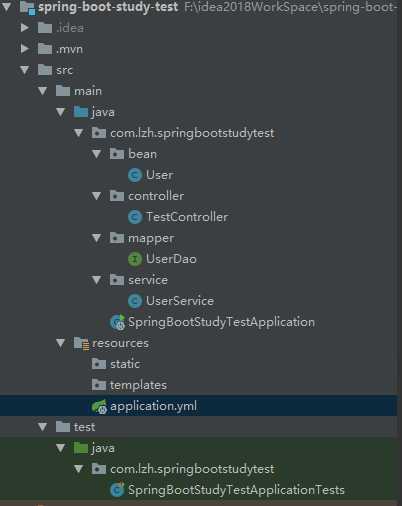SpringBoot整合redis缓存(一)
2020-12-13 14:24
标签:delete beans fail opera select uname table from camel 1.Linux系统 2.安装redis(也可以安装docker,然后再docker中装redis,本文章就直接用Linux安装redis做演示) redis下载地址:http://download.redis.io/releases/redis-4.0.14.tar.gz 找到redis中的redis.conf文件并编辑(在安装路径中找到) 1、找到bind 127.0.0.1并注释掉 默认127.0.0.1只能本地访问,注释掉即可ip访问 2、修改 protected-mode 属性值为no 注释掉并把保护模式禁用以后可以IP访问 3、修改daemonize属性将no 改为yes 将daemonize设置为yes即启动后台运行 4、开放6379端口 默认不对外开放6379 5、启动redis redis-server默认在/usr/local/bin路径下,redis.conf在redis的安装路径下 6、测试连接 redis-cli -h redis服务器IP -p 6379 -a 密码(没有设置redis密码不要写空,否则报错) 项目源码结构 一个user表 pom.xml文件(可以根据自己的需要来添加或修改) 下面是springboot的配置文件application.yml,配置redis(里面都有注释解释) 接着是实体类,这个比较简单就不多说了 这是controller类,用于暴露接口访问 接着是Mapper持久层Dao,这里主要用注解写比较方便,也可以使用mybatis的xml配置文件写sql语句 service层,这里主要是使用redis模板来写 执行spring boot的启动类,访问http://localhost:8081/findUserById?id=1 再次访问http://localhost:8081/findUserById?id=1就是从缓存中获取保存的数据 SpringBoot整合redis缓存(一) 标签:delete beans fail opera select uname table from camel 原文地址:https://www.cnblogs.com/lzhdonald/p/11560002.html准备工作
修改redis,开启远程访问
vim ./redis.conf
/sbin/iptables -I INPUT -p tcp --dport 6379 -j ACCEPT
redis-server /myconf/redis.conf
redis-cli -h 192.168.126.129 -p 6379

Java代码编写
目录结构


代码
server:
port: 8081
#数据库连接
spring:
datasource:
url: jdbc:mysql://localhost:3306/mytest_springboot_cache?useUnicode=true
driver-class-name: com.mysql.jdbc.Driver
username: root
password: lzh
## Redis 配置
redis:
## Redis数据库索引(默认为0)
database: 0
## Redis服务器地址
host: 192.168.126.129
## Redis服务器连接端口
port: 6379
## Redis服务器连接密码(默认为空)
password:
jedis:
pool:
## 连接池最大连接数(使用负值表示没有限制)
#spring.redis.pool.max-active=8
max-active: 8
## 连接池最大阻塞等待时间(使用负值表示没有限制)
#spring.redis.pool.max-wait=-1
max-wait: -1
## 连接池中的最大空闲连接
#spring.redis.pool.max-idle=8
max-idle: 8
## 连接池中的最小空闲连接
#spring.redis.pool.min-idle=0
min-idle: 0
## 连接超时时间(毫秒)
timeout: 1200
#将themilef的默认缓存禁用,热加载生效
thymeleaf:
cache: false
#mybatis的下划线转驼峰配置
configuration:
map-underscore-to-camel-case: true
#另外一种打印语句的方式
log-impl: org.apache.ibatis.logging.stdout.StdOutImpl
#打印sql时的语句
logging:
level:
com:
acong:
dao: debug
file: d:/logs/bsbdj.log
package com.lzh.springbootstudytest.bean;
import java.io.Serializable;
/**
* @author lzh
* create 2019-09-18-22:32
*/
public class User implements Serializable {
private static final long serialVersionUID = 1L;
private int uid;
private String userName;
private String passWord;
private int salary;
public int getUid() {
return uid;
}
public void setUid(int uid) {
this.uid = uid;
}
public String getUserName() {
return userName;
}
public void setUserName(String userName) {
this.userName = userName;
}
public String getPassWord() {
return passWord;
}
public void setPassWord(String passWord) {
this.passWord = passWord;
}
public int getSalary() {
return salary;
}
public void setSalary(int salary) {
this.salary = salary;
}
public User(int uid, String userName, String passWord, int salary) {
super();
this.uid = uid;
this.userName = userName;
this.passWord = passWord;
this.salary = salary;
}
public User() {
super();
}
}
package com.lzh.springbootstudytest.controller;
import com.lzh.springbootstudytest.bean.User;
import com.lzh.springbootstudytest.service.UserService;
import org.springframework.beans.factory.annotation.Autowired;
import org.springframework.stereotype.Controller;
import org.springframework.web.bind.annotation.RequestMapping;
import org.springframework.web.bind.annotation.RequestParam;
import org.springframework.web.bind.annotation.ResponseBody;
import org.springframework.web.bind.annotation.RestController;
import java.util.HashMap;
import java.util.List;
import java.util.Map;
/**
* @author lzh
* create 2019-09-18-22:36
*/
@RestController
public class TestController {
@Autowired
private UserService userService;
@RequestMapping("/queryAll")
public List
package com.lzh.springbootstudytest.mapper;
import com.lzh.springbootstudytest.bean.User;
import org.apache.ibatis.annotations.*;
import java.util.List;
/**
* @author lzh
* create 2019-09-18-22:32
*/
@Mapper
public interface UserDao {
@Select("select * from user")
List
package com.lzh.springbootstudytest.service;
import com.lzh.springbootstudytest.bean.User;
import com.lzh.springbootstudytest.mapper.UserDao;
import org.springframework.beans.factory.annotation.Autowired;
import org.springframework.data.redis.core.RedisTemplate;
import org.springframework.data.redis.core.ValueOperations;
import org.springframework.stereotype.Service;
import java.util.List;
import java.util.concurrent.TimeUnit;
/**
* @author lzh
* create 2019-09-18-22:33
*/
@Service
public class UserService {
@Autowired
private UserDao userDao;
@Autowired
private RedisTemplate redisTemplate;
public List
这里主要是使用RedisTemplate来对远程redis操作,每次访问controller暴露的接口,首先判断redis缓存中是否存在该数据,若不存在就从数据库中读取数据,然后保存到redis缓存中,当下次访问的时候,就直接从缓存中取出来。这样就不用每次都执行sql语句,能够提高访问速度。 但是在保存数据到缓存中,通过设置键和值和超时删除,注意设置超时删除缓存时间不要太长,否则会给服务器带来压力。

